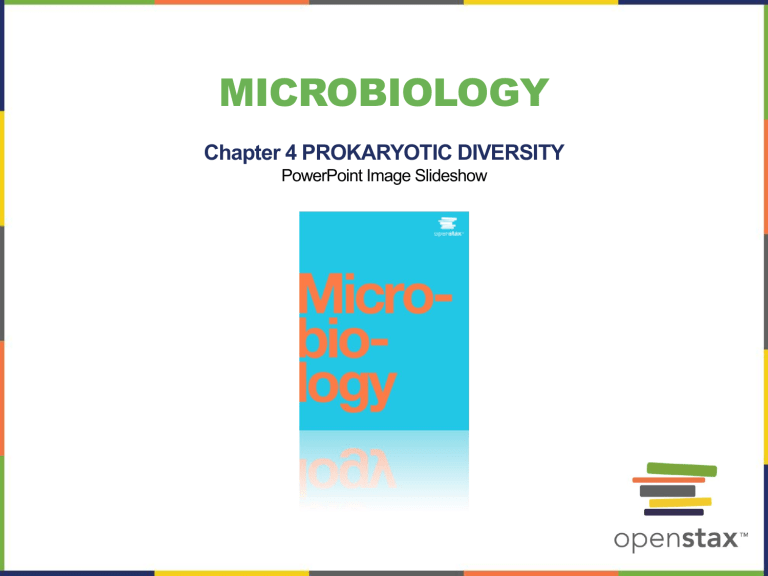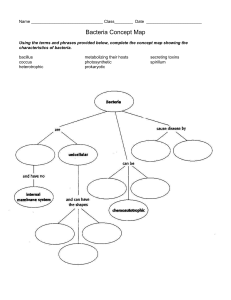
MICROBIOLOGY
Chapter 4 PROKARYOTIC DIVERSITY
PowerPoint Image Slideshow
NONPROTEOBACTERIA
GRAM-NEGATIVE BACTERIA AND
PHOTOTROPHIC BACTERIA
• Spirochetes
– Long (up to 250 μm)
– Spiral-shaped bodies
– Very thin
– Very difficult to culture
– highly motile, using their axial filament to propel
themselves
FIGURE 4.13
The flagella found between the inner and outer
membranes of spirochetes wrap around the bacterium,
causing a twisting motion used for locomotion. (credit
“spirochetes” micrograph: modification of work by Centers
for Disease Control and Prevention; credit “SEM/ TEM”:
modification of work by Guyard C, Raffel SJ, Schrumpf
ME, Dahlstrom E, Sturdevant D, Ricklefs SM, Martens C,
CFB Group
– Share some similarities in the sequence of nucleotides
in their DNA
– Rod-shaped bacteria
– Anaerobic environments (ie. gums, gut, and rumen)
– Fermenters (ie. process cellulose in rumen, thus
enabling ruminant animals to obtain carbon and energy
from grazing)
Cytophaga
– Motile aquatic bacteria that glide
• Fusobacteria
– Inhabit the human mouth and may cause severe
infectious diseases
• Bacteroides
– Largest genus of the CFB group
– Species are prevalent inhabitants of the human
large intestine
FIGURE 4.14
Bacteroides comprise up to 30% of the normal
microbiota in the human gut. (credit: NOAA)
GRAM-NEGATIVE BACTERIA AND PHOTOTROPHIC
BACTERIA
• Phototrophic bacteria:
– Large and diverse group
– Use solar energy to synthesize ATP through
photosynthesis
• Oxygenic - produce oxygen during photosynthesis
(Cyanobacteria)
• Anoxygenic (green/purple sulfur and nonsulfur
bacteria)
FIGURE 4.16
Purple and green sulfur bacteria use bacteriochlorophylls
to perform photosynthesis.
Phototrophic bacteria:
• Cyanobacteria-produce oxygen during
photosynthesis
• Blue-green color from the chlorophyll in their cells
• Many Fix nitrogen
• Many habitats
FIGURE 4.17
(a) Microcystis aeruginosa is a type of cyanobacteria commonly found in freshwater environments.
(b) In warm temperatures, M. aeruginosa and other cyanobacteria can multiply rapidly and
produce neurotoxins, resulting in blooms that are harmful to fish and other aquatic animals.
(credit a: modification of work by Dr. Barry H. Rosen/U.S. Geological Survey; credit b:
modification of work by NOAA)
GRAM-POSITIVE BACTERIA
• Thick peptidoglycan cell wall- retain purple stain in
Gram staining
• Two groups:
– Actinobacteria: high G+C (more than 50%
guanine and cytosine nucleotides in their DNA)
– Bacilli: low G+C (less than 50% of guanine and
cytosine nucleotides in their DNA)
ACTINOBACTERIA: HIGH G+C GRAM-POSITIVE
BACTERIA
• Very Diverse
• Often pleomorphic; branching filaments
• Often common inhabitants of soil
• Majority are aerobic
FIGURE 4.18
(a) Actinomyces israelii (false-color scanning electron
micrograph [SEM]) has a branched structure.
(b) Corynebacterium diphtheria causes the deadly
disease diphtheria. Note the distinctive palisades.
(c) The gramvariable bacterium Gardnerella vaginalis
causes bacterial vaginosis in women. This micrograph
shows
a Pap smear from a woman with vaginosis. (credit a:
modification of work by “GrahamColm”/Wikimedia
FIGURE 4.19
Clostridium difficile, a gram-positive, rod-shaped bacterium, causes severe colitis and
diarrhea, often after the normal gut microbiota is eradicated by antibiotics. (credit:
modification of work by Centers for Disease Control and Prevention)
FIGURE 4.20
(a) A gram-stained specimen of Streptococcus pyogenes shows the chains of cocci
characteristic of this organism’s morphology.
(b) S. pyogenes on blood agar shows characteristic lysis of red blood cells, indicated
by the halo of clearing around colonies. (credit a, b: modification of work by
American Society for Microbiology)
ACTINOBACTERIA: HIGH G+C GRAM-POSITIVE
BACTERIA
• Actinomyces
• Actinomyces spp. play an important role in soil
ecology, and some species are human pathogens
FIGURE 4.23
M. tuberculosis grows on Löwenstein-Jensen (LJ) agar in distinct colonies. (credit:
Centers for Disease Control and Prevention)
Actinomyces
• Mycobacterium
– Outermost layer of mycolic acids that is waxy and
water-resistant
– Often slow-growing
– Important cause of diverse infectious diseases:
• M. tuberculosis causes tuberculosis
• M. leprae causes Hansen’s disease (leprosy)
Actinomyces
• Corynebacterium
– Majority are nonpathogenic
– C. diphtheriae causes diphtheria
LOW G+C GRAM-POSITIVE BACTERIA
• Clostridia
• Clostridium
– Endospore-producing
– Obligate anaerobes
– Clostridium spp. produce more kinds of protein
toxins than any other bacterial genus, and several
are human pathogens:
– C. tetani, C. botulinum, C. perfringens (food
poisoning and gangrene), and C. difficile
LOW G+C GRAM-POSITIVE BACTERIA
• Lactobacillales
– Lactobacillus, Leuconostoc, Enterococcus, and
Streptococcus
• Aerotolerant anaerobes ('tolerate' oxygen but do not
grow in it)
•Produce lactic acid from simple carbohydrates
• Lactobacillus colonize the body and are used
commercially in food production
Lactobacillales
• Streptococcus
• Spherical in chains
• Produce enzymes that destroy tissue
• Beta-hemolytic streptococci hemolyze blood agar;
includes S. pyogenes - bacterial pharyngitis (strep throat)
and skin infections (mild to life threatening)
• Non-beta-hemolytic streptococci include S.
pneumoniae (diplococci)- pneumonia and other respiratory
infections and S. mutans, which causes dental caries
Bacilli
• Morphologically diverse class that includes
bacillus shaped and coccus-shaped genera
• Bacillus are bacillus in shape and can produce
endospores
– Aerobes or facultative anaerobes
– Some are used in various industries:
• production of antibiotics
• enzymes (BamH1 restriction endonuclease)
• detergents
FIGURE 4.21
(a) In this gram-stained specimen, the violet rod-shaped cells forming chains are the gram-positive
bacteria Bacillus cereus. The small, pink cells are the gram-negative bacteria Escherichia coli.
(b) In this culture, white colonies of B. cereus have been grown on sheep blood agar. (credit a:
modification of work by “Bibliomaniac 15”/Wikimedia Commons; credit b: modification of work
by Centers for Disease Control and Prevention)
Bacilli
• Clinically important Bacillus:
• B. anthracis causes anthrax, a severe disease that
affects wild and domesticated animals and can spread
from infected animals to humans
• B. cereus may cause food poisoning
– Colonies appear milky white with irregular shapes
when cultured on blood agar
Bacilli
• Staphylococcus also belongs to the class Bacilli,
even though its shape is coccus (grape-like clusters)
• Facultative anaerobic, halophilic, and nonmotile
• Most studied species are:
– S. epidermidis: found on human skin, opportunistic
pathogen, infections associated with intravenous
catheters
– S. aureus: skin infections, wound infections, can
produces an enterotoxin, food poisoning, toxic shock
syndrome, is often antibiotic resistant
EXERCISE 48 (FIGURE 4.29)
(credit: modification of work by Janice Haney Carr/Centers for Disease Control and
Prevention)
ARCHAEA
• Very diverse, are found in any habitat
• Some are mesophiles, and many are
extremophiles
(conditions hostile to most other living forms)
• They can produce methane
• Few found in human microbiomes and no
known human pathogen



